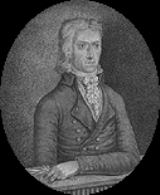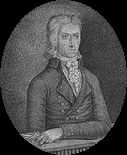
August Batsch
Encyclopedia

Germans
The Germans are a Germanic ethnic group native to Central Europe. The English term Germans has referred to the German-speaking population of the Holy Roman Empire since the Late Middle Ages....
naturalist
Naturalist
Naturalist may refer to:* Practitioner of natural history* Conservationist* Advocate of naturalism * Naturalist , autobiography-See also:* The American Naturalist, periodical* Naturalism...
. He was a recognised authority on mushrooms, and also described new species of fern
Fern
A fern is any one of a group of about 12,000 species of plants belonging to the botanical group known as Pteridophyta. Unlike mosses, they have xylem and phloem . They have stems, leaves, and roots like other vascular plants...
s, bryophytes, and seed plants.
Life and career
Batsch was born in JenaJena
Jena is a university city in central Germany on the river Saale. It has a population of approx. 103,000 and is the second largest city in the federal state of Thuringia, after Erfurt.-History:Jena was first mentioned in an 1182 document...
, Germany
Germany
Germany , officially the Federal Republic of Germany , is a federal parliamentary republic in Europe. The country consists of 16 states while the capital and largest city is Berlin. Germany covers an area of 357,021 km2 and has a largely temperate seasonal climate...
, to George Lorenz Bratsch and Ernestine (nee Franke) Bratsch. He studied at the city school, and then had private tuition. He showed an aptitude for natural sciences, and so subsequently studied at the University of Jena
Jena
Jena is a university city in central Germany on the river Saale. It has a population of approx. 103,000 and is the second largest city in the federal state of Thuringia, after Erfurt.-History:Jena was first mentioned in an 1182 document...
(now known as the Friedrich Schiller University of Jena
Friedrich Schiller University of Jena
Friedrich Schiller University of Jena , is a public research university located in Jena, Thuringia, Germany....
), entering in 1772 and obtaining his doctorate
Doctorate
A doctorate is an academic degree or professional degree that in most countries refers to a class of degrees which qualify the holder to teach in a specific field, A doctorate is an academic degree or professional degree that in most countries refers to a class of degrees which qualify the holder...
in 1781. Batsch was married in 1787 to Amalie Pfaundel. They had three children, Friedrich (born 1789), George Friedrich Karl (1792), and Karoline (1795). He died in 1802 after a short illness.
In 1786, he obtained a further doctorate in medicine
Medicine
Medicine is the science and art of healing. It encompasses a variety of health care practices evolved to maintain and restore health by the prevention and treatment of illness....
, and began to teach natural history
Natural history
Natural history is the scientific research of plants or animals, leaning more towards observational rather than experimental methods of study, and encompasses more research published in magazines than in academic journals. Grouped among the natural sciences, natural history is the systematic study...
at the university the same year.
In 1787, he began teaching medicine at the university. In 1792, became Professor of Philosophy
Philosophy
Philosophy is the study of general and fundamental problems, such as those connected with existence, knowledge, values, reason, mind, and language. Philosophy is distinguished from other ways of addressing such problems by its critical, generally systematic approach and its reliance on rational...
. He advised Johann Wolfgang von Goethe
Johann Wolfgang von Goethe
Johann Wolfgang von Goethe was a German writer, pictorial artist, biologist, theoretical physicist, and polymath. He is considered the supreme genius of modern German literature. His works span the fields of poetry, drama, prose, philosophy, and science. His Faust has been called the greatest long...
on his botanical research.
In 1790, Batsch founded a botanical garden in Jena, and the Naturforschende Gesellschaft ("Nature Investigator's Club").
Botany
Batsch discovered almost 200 new species of mushroomMushroom
A mushroom is the fleshy, spore-bearing fruiting body of a fungus, typically produced above ground on soil or on its food source. The standard for the name "mushroom" is the cultivated white button mushroom, Agaricus bisporus; hence the word "mushroom" is most often applied to those fungi that...
s, including Clitocybe nebularis
Clitocybe nebularis
Clitocybe nebularis or Lepista nebularis, commonly known as the clouded agaric or cloud funnel, is an abundant gilled fungus which appears both in conifer-dominated forests and broad-leaved woodland in Europe and North America...
, Calocera cornea
Calocera cornea
Calocera cornea is a jelly fungus that grows on decaying wood. It is a member of the Dacrymycetales, an order of fungi characterized by their unique "tuning fork" basidia....
, Paxillus involutus
Paxillus involutus
Paxillus involutus, commonly known as the brown roll-rim, common roll-rim, or poison pax, is a basidiomycete fungus widely distributed across the Northern Hemisphere. It has been unintentionally introduced to Australia, New Zealand, and South America, where it has likely been transported in soil...
, and Tapinella atrotomentosa
Tapinella atrotomentosa
Tapinella atrotomentosa, commonly known as the velvet roll-rim or velvet-footed pax, is a species of fungus in the Tapinellaceae family of the Agaricales, or gilled mushrooms. It was originally described as Paxillus atrotomentosus by German naturalist August Batsch, and given its current name by...
. He was a recognised authority writing two books on the topic, Elenchus Fungorum (Discussion of Fungi, between 1783 and 1789), which is still highly rated today and Versuch einer Anleitung zur Kenntniss und Geschichte der Pflanzen (Attempt at Instruction in the Knowledge and History of Plants, between 1787 and 1788). Versuch einer Anleitung... looked into the nature of what we now know to be fungal
Fungus
A fungus is a member of a large group of eukaryotic organisms that includes microorganisms such as yeasts and molds , as well as the more familiar mushrooms. These organisms are classified as a kingdom, Fungi, which is separate from plants, animals, and bacteria...
disease
Disease
A disease is an abnormal condition affecting the body of an organism. It is often construed to be a medical condition associated with specific symptoms and signs. It may be caused by external factors, such as infectious disease, or it may be caused by internal dysfunctions, such as autoimmune...
s of plants (such as Dutch elm disease
Dutch elm disease
Dutch elm disease is a disease caused by a member of the sac fungi category, affecting elm trees which is spread by the elm bark beetle. Although believed to be originally native to Asia, the disease has been accidentally introduced into America and Europe, where it has devastated native...
), but without realizing their origin.
External links
- Plate Plate from Elenchus fungorum.
- Text of Elenchus Fungorum (GermanGerman languageGerman is a West Germanic language, related to and classified alongside English and Dutch. With an estimated 90 – 98 million native speakers, German is one of the world's major languages and is the most widely-spoken first language in the European Union....
) - University of Jena botanical garden

